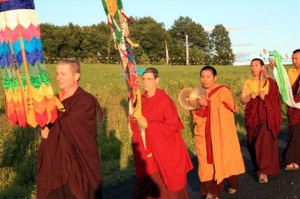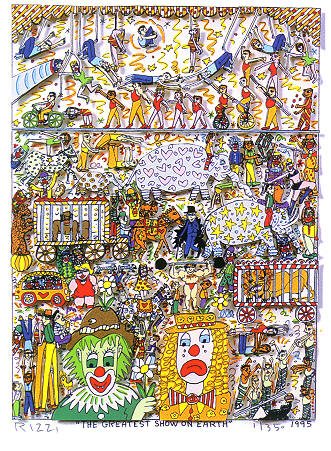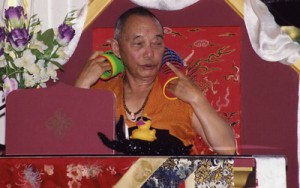An excerpt from the Mindfulness workshop given by Jetsunma Ahkon Lhamo in 1999
I want to talk to the monks and nuns about how to keep mindfulness, the awareness of emptiness and bodhicitta as being the true meaning of one’s path, one’s practice: the two eyes. Somehow, we have to embark more deeply on practicing a way to attain pure View. What keeps us from attaining pure View? It’s our constant need to recognize and reaffirm self-nature as being inherently real, and then the rest of it – our desire, our clinging, our egos. And then there’s always the reaction going on. We have to see that. These are the reasons why we are asleep in this narcotic state. As a monk or a nun, we should be constantly striving for a state of deeper recognition, for a better sense of View. How can we do that?
We have all kinds of ideas about how we should relate with one another. We have all kinds of ideas about how we should conduct ourselves, carry ourselves. My suggestion is that we develop some new patterns, some new habitual tendencies so that we can develop something other than that strong sense of I-ness, of ego-clinging. Remember that the point is to recognize what is sacred. That may not coincide with what you think; it may not coincide with what you want; it may not coincide with the way you’re used to doing things. But that’s okay, because the point of practicing Dharma is to change. It’s not to remain the same, right?
Now, all you feminists, calm down. When the Buddha first taught, he taught men, right? Those were the first aspirants. There are all kinds of traditions about nuns sitting in the back and monks sitting in the front, and because we’re all feminists and we’re all girls, we don’t like that very much. But like it or not, the Buddha taught men first, and so the idea is not to worry about what body we’re wearing right now, what ego we’re stuck in right now. In fact, to identify with being ordinary males and females and to think, “Oh, females have to be there and men have to be there,” is to stay stuck in ego. So the reason for women to practice an honoring of monks is not because men are better, but because the Buddha taught men first. They are our eldest practitioners. They held the Lineage all this time and made it possible. It is the ordained male sangha that held the full Lineage of ordination intact through all this time and made it possible for ordination to occur today in its fullness, both genyen and gelong. So that has been held properly by men. So as nuns, we should honor the monks.
The monks, however, should not honor themselves. The monks should honor the women, the nuns, because in pure View, she is the Goddess. She is Tara herself. Her nature is indistinguishable from what is most precious to us, so as a Vajrayana practitioner, women are elevated. She is the Goddess, she is Tara, she is the spiritual consort. She is the one with whom we can practice in such a way as to overcome samsara, so she is extraordinarily elevated.
So the nuns get to lose their egos by honoring the monks as the primary practitioners who, through their generosity, morality and kindness, have kept the vows all this time and have made it possible for us to practice in the way that we are now. That should be something you should think about every time you see a monk, good or bad. Get out of the habit of saying, “Oh, that one’s a good monk, and that one’s a bad monk.” When you see those robes and they’re on a monk, you should feel exactly the same. The same thing applies for the monks. You should not worry about feeling that way about yourself. You’re here. That’s good. So the monks, when they look at women, they should not see a good nun or a bad nun or one that’s dressed one way or one that’s dressed another way. They shouldn’t see that. These women who are holding the robes of the Buddha, who are practicing in that way, are nothing less than Tara incarnate. They are nothing less than the appearance of the Goddess. The only hope any of us have is to practice in spiritual union, whether that’s on a spiritual level or on a physical level, and so when we look at the female principle, she is everything. Every time a monk looks at a woman, particularly a nun, he should see the Goddess. It should be like that, even if it’s a laywoman. You’re not looking at the clothes, remember? See the nature. Behold the Goddess, and in that way, develop the habit of just doing that little bow. Nobody has to see it, men! It’s okay! It could be like one vertebra, you know? Pick a vertebra. I realize what a hard time men have with that – women, too. It’s this battle between the sexes. But that is ordinary phenomena, and we’re trying to get around that, past that, through that.
The point is to carry the View and recognize the nature of one another without holding ourselves in high regard because we are so “fancy.” The point is to carry the View without getting the ‘rah-rah nuns’ or ‘rah-rah monks’ thing going: I’ve heard the nuns say, “You know, the monks never support one another. They’re not being nice to one another. They don’t cook for each other. They don’t make each other’s beds. They don’t do anything for each other.” That’s what I hear from the nuns. And the monks are saying, “You know, the nuns, they’re sloppy. They just run around doing ooh-ooh, ah-ah stuff, all those hugs and squeezes and all that stupid stuff. They’re not very together.” We tend to think like that and we have these ideas. It’s that kind of thing that creates not only dissension in the sangha, but it’s also ordinary view. What do you have to do with that? What is the point of practicing as you do without holding View? There would be no point.
© Jetsunma Ahkön Lhamo



